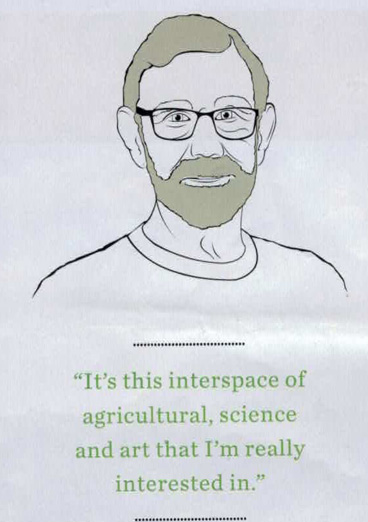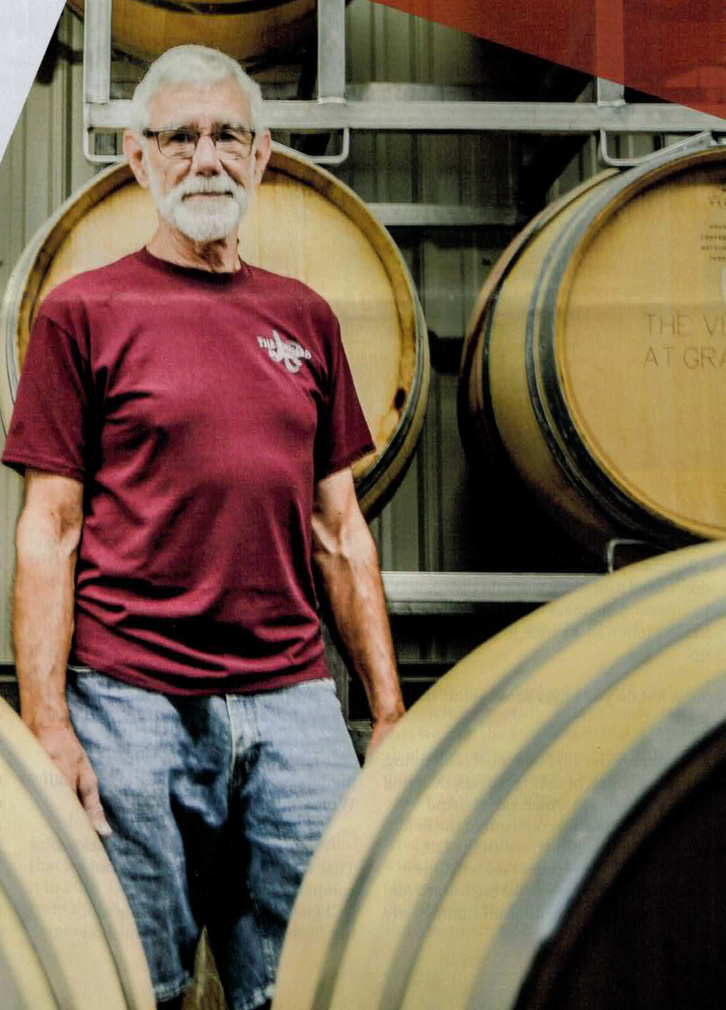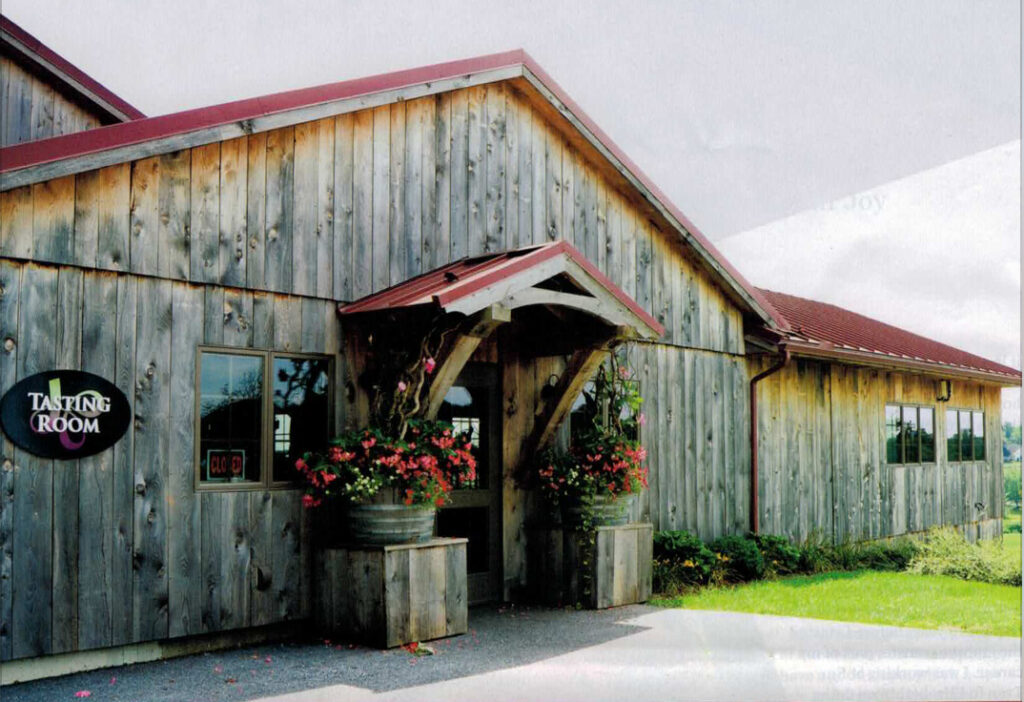A grand view: vintner blends science and taste in Mount Joy
FOR PEOPLE WHO LOVE LANCASTER COUNTY
OCT . 3 0 , 20 16 • IS S U E NO. 3 8
THE SUNDAY INTERVIEW
Perfect blend: Larry Kennel finds next career as winemaker in Mount Joy

“It’s this interspace of agricultural, science and art that I’m really interested in. 0n a splendid late summer afternoon, Larry Kennel, winemaker at the Vineyard at Grandview in Mount Joy, and I are sitting at a table inside his tasting room. From here, we can see his vinifera vines with cabernet sauvignon, merlot, chardonnay and albarifio grapes growing on the vineyard’s soft southern slope.
To me, it’s the perfect setting for a sip of chardonnay. To Kennel, it’s a living science project. In the vines Kennel sees complex chemical changes occurring every minute. He meticulously manages the canopy of the finicky cabernet sauvignon vines to increase photosynthesis. He spends hours in his lab testing the acidity of his wines, measuring spoilage and introducing bacteria into the barrels to test for malolactic fermentation. And he stops the fermentation process of his moscato to give it a subtle fizzy mouthfeel. Where I see tiny bubbles, Kennel sees the structural diagrams of molecules.
As the owner of Cornerstone Genetics, a cattle embryo transfer business, Kennel applies his vast knowledge of science to winemaking. “The whole chemistry that I was taught in veterinary school is helpful,”he says. As afternoon slides into early evening, Kennel, 69, talks about the turns his life has taken. Soon, he’ll retire from the cattle embryo business and train his full attention to making wine.
What makes this particular property so good for growing grapes?
We sit in a rain shadow, which is actually quite good for the vineyard. We don’t get as much rain as the rest of Lancaster County, which is good for new vines. You can watch the thunderstorms on the radar come in from Harrisburg and split, and part of it will go down and follow the river south and come around through Mount Joy or south. The other half will go around this hill north of us and go into Lebanon County. And they will often come back together again on the other side of Manheim.
We live in an area in northwestern Lancaster County that is not as good for growing corn and soybeans and alfalfa. There’s an area that runs from Rheems to Manheim to the hill over here toward Lebanon County that bas a soil known as Bennington loam. It’s a very well-drained soil. We also have a nice slope here to the south. All of our reds are on this top side where we have a good slope, which helps with drainage and also tilts the vines toward the sun in the south, so that gives you a little more aspect to the sun.
Did you purchase this property planning to turn it into a winery?
No, just a place to live. We bought 23 acres in ’85. It was farmland. Originally it had some orchard on it. I did mostly fruits when I first started making wine as a hobby. I found out that our soils were very similar to the soil that Waltz Vineyard in Manheim has. Their grapes were being used in some of the best wines here in southeastern Pennsylvania. So, I knew that the soils were really good for growing grapes here.

What sparked your interest in wine making?
Winemaking is this intersection between art and science. I worked on farms as a teenager and in college. My interest is in agriculture. So, it’s the interspace of agricultural, science and art that I’m really interested in. The first time I made wine was back in ’74. But, I really didn’t start back into it in any regular basis until about ’04. As I did some home winemaking, I realized how hard it was and how much of an art it was. I’ve always been interested in research and doing studies and that’s part of winemaking.
You were a veterinarian before becoming a professional winemaker.
I grew up in Chester County and graduated from veterinary school in ’73. I was in a general practice in Gap for 10 years before I started the embryo transfer part of my career. I was working at EmTran in Elizabethtown doing embryo transfer in cattle. Then I started my own embryo transfer business in ’86 and have been doing that ever since. I’m about to retire very soon. I have a full-time job here at the vineyard, so I don’t need a lot more work on the road. It’s been a good business for us, but I’ll be 70 in December, so it’s time to give something up.
What do you enjoy most about the job?
Probably the job I like most is blending. Blending wines, blending barrels, deciding what wine goes in which variety. And also seeing the crop come out of the field. Picking is an exciting time. In the fall, when we start to pick and see what the crop looks like, that’s a real big reward for the hard work you’ve done all summer, in fact, for years.
This business must really teach you to be patient.
Yeah, it does, because you plant vines and it’s generally three years before you get a small crop, then it’s another year or two before you get things in bottle, and another six months or a year before you release it. So you do learn some patience.
In June, some of your wines won medals in the San Francisco International Wine Competition.
We don’t enter a lot of competitions. That was probably only the second competition we entered. I guess it’s a good marketing tool, but from what I’ve seen, if you enter enough competitions, you will win some medals. So, wineries will often enter lots of competitions, and of course, nobody knows the ones that you didn’t win. I’ve also tasted wines that won medals in some competitions and I wonder why they ever won medals. So, if we’re going to enter a competition we want it to be a prestigious competition and we want it to mean something if you win. We entered five wines. The categories that we entered were chardonnay, cabernet franc, cabemet sauvignon and then we entered our Crimson Quartet, which is a Bordeaux blend, in the Bordeaux Blend Over $25 category and then we entered our Grande Rouge in the same category. There are 45 judges from all over the world and there are approximately over 4,500 wines entered in to the competition. The chardonnay won a bronze. The cabernet franc, cabernet sauvignon and the Crimson Quartet won silver and the Grande Rouge won a double gold. We are the first any winery in the mid-Atlantic area to win a double gold in that competition. To get a double gold, every judge must give it a gold. That’s pretty amazing for a fairly new winery. I don’t think we’ ll have any trouble selling out of the Grande Rouge. It’s a wine that we will not make every year. I made it in 2013. I didn’t in ’14. I won’t this year from the ’15 grapes. We’ll see what the grapes look like in ’16. I only make that wine in the best years where we can pick out barrels to make that-wine the quality that l want.
Your moscato is a pretty good seller, too.
That’s one of our best sellers by volume. We call it Precious Pink. It’s a moscato that we stop the fermentation at 8 percent alcohol by cooling it down. It’s a little difficult to get it stopped, but if you use a yeast that doesn’t have a high alcohol tolerance- that helps. And you have to have a good chilling system to cool the wine down. The yeast likes to be up in the 60s or 70s to really work, and so, if you chill it down to 30 or 28, that pretty much stops fermentation. (The sugar and cold temperature) maintain a level of carbon dioxide, which is produced during fermentation, so that gives this wine just a little fizz. It’s not a Champagne style by any stretch of the imagination. It lightens the wine. And even though the sugar levels are actually pretty high. it doesn’t taste as sweet as it is because of those little carbon dioxide bubbles lightening the wine a little bit.
Will you continue making that even though it’s such a complicated process?
After the first time, I told Sarah. who is the daughter that really wanted me to make that wine, “I’m not making it anymore. It’s too much of a pain to make.”So, the girls said, “But, Dad, they like it.” We really like to be known here for our good dry wines. That’s the case with a lot of wineries, because that’s often where the quality can really shine through. But we also understand that there are a lot of people that don’t like drinking dry wines. When we start blending sugars for our sweet wines, we try to keep the wines so that they’re not overly sweet- so you don’t end up with these sweet tastes and that’s all that you taste in your mouth. I think if you can maintain that balance between sweetness and tartness. you end up with a much better product. I t’s cleaner and you don’t finish with a cloyingly sweet taste in your mouth.
One criticism I’ve heard is that Pennsylvania wines are too sweet.
It is a reputation that we have. I think there are a number of wineries here in southeastern Pennsylvania that are doing a really good job with dry wines. I think it’s only a matter of years before Pennsylvania will become a destination for dry wines. But it does take some education of winemakers and also customers.
Have you done any unique blends?
We’ve not done anything real out of the ordinary for vinifera. Of course, the Bordeaux blends are what’s really interesting for me. If you use a merlot heavy Bordeaux blend, you tend to get a smoother, earlier-drinking wine. If you use a Cabernet-heavy blend it tends to be not as smooth to begin with, but it has a lot more structure and can maybe last longer. Those are some factors when you start blending grapes. We have an interesting wine that a lot of people don’t have. We make a black cherry that we age in Jack Daniels barrels. That’s an interesting wine that a lot of people like. It’s semi-sweet. The whiskey barrels are very heavily charred so that lends kind of a smoky flavor to the wine. We get barrels right after they empty the whiskey out of them. My grandfather had a cherry tree in his backyard that we picked cherries from when we were growing up, so that was a favorite fruit of mine. He also had whiskey in a closet upstairs. So, that’s the idea to age the cherries in whiskey barrels.

Winemaking sounds like a business that you can’t just jump into and expect to figure it all out for yourself.
It’s pretty difficult. It really helps to have people to help you out. I’m really grateful to other winemakers and other grape growers, especially here in southeastern Pennsylvania that have been very forthcoming with any information. I use Tom Payette, out of Virginia, as my winery consultant. So when I run into questions, I call him. When we’re in wine making gear here, I call him sometimes two or three times a week to make sure I’m on the right track. Jan Waltz, who has the vineyard here in Manheim. was instrumental in helping us choose the best clones of different varieties and using the best root stocks for our area He’s been growing grapes for 25 years and was just a tremendously valuable asset in helping us get this vineyard started. Mark Chen did a really nice job when he was here as the wine grape extension agent from Penn State. He was based here in Lancaster County and he brought in lots of educators from all over the world to teach us how to make good wine. He was a big help.
It makes sense that winemakers would help each other. I imagine that the more quality vineyards that Lancaster County has, the quicker Lancaster County becomes a wine destination. And that benefits everyone.
Right. and most people in the industry here in Pennsylvania understand that. It pays to help each other and really get this industry top notch across the board, and then it becomes a destination for people outside the state to come in and visit us. If you only have one or two vineyards that are doing a really nice job, it’s not enough to bring people in from a distance. But if you have the quality that’s starting to be developed here in southeastern Pennsylvania, it’s just a matter of time before it’s well known.
By Mike Andrelczyk

